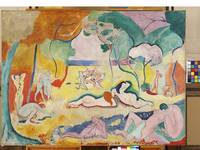Art Meets Chemistry: Revealing Hidden Images and Vanishing Masterpieces in Paintings
09/13/10
Contributed by Maria Russell
 The Chemistry Department invites Jennifer Mass, Senior Scientist from Winterthur Museum, Delaware to give a presentation on "Art Meets Chemistry: Revealing Hidden Images and Vanishing Masterpieces in Paintings". All are invited to attend WEDNESDAY, September 22, 2010 at 4:00p.m in the Center for Natural Sciences room 112.
The Chemistry Department invites Jennifer Mass, Senior Scientist from Winterthur Museum, Delaware to give a presentation on "Art Meets Chemistry: Revealing Hidden Images and Vanishing Masterpieces in Paintings". All are invited to attend WEDNESDAY, September 22, 2010 at 4:00p.m in the Center for Natural Sciences room 112.
The scientific analysis of objects of art is carried out to address questions about a work’s authenticity, construction, state of preservation, and mechanisms of degradation. Given the irreplaceable nature of the works studied, this research must be conducted either totally nondestructively or on microsamples alone. Matisse’s iconic and controversial work, Le Bonheur de vivre (The Joy of Life, 1905-1906, The Barnes Foundation) was examined to identify the origin of the fading, discoloration, chalking, and spalling of the yellow paints. Visual comparison of this work with Matisse’s painted studies located at the Statens Museum for Kunst in Copenhagen, The Barnes Foundation, and the San Francisco Museum of Modern Art reveals substantial color shifts in the foliage in the upper left corner and fading of the yellow paints below the central reclining figures. An XRF mapping of the work demonstrated that the painting was executed with both chrome yellow (PbCrO4) and cadmium yellow (CdS) pigments, but that the discoloration and flaking were confined to the cadmium yellow regions. Microsamples of the cadmium yellows were examined by XANES, SEM-EDS, FTIR, and Raman spectroscopies. The light and RH levels required to initiate the discoloration and flaking respectively are currently being investigated for the work’s reinstallation in Philadelphia.
Recent research also includes confocal x-ray fluorescence microscopy at the Cornell High Energy Synchrotron Source (CHESS) that has been used with conventional microanalytical methods to nondestructively reproduce a buried painting by N.C. Wyeth. N. C. (Newell Convers) Wyeth (1882-1945) is an iconic American artist best known for his famous illustrations for the works of Robert Lewis Stevenson and for popular magazines like the Saturday Evening Post. Several of his most valued illustrations have been lost from view because they were painted over, either by N.C. himself or by his son, groundbreaking 20th century American artist Andrew Wyeth. The first virtual reproduction of one of Wyeth’s buried works is presented here. Finally, an investigation of The Armorer’s Shop (1644), attributed to Flemish genre painter David Teniers the Younger (1610-1690) has also recently been conducted. Confocal data, along with dendrochronological and infrared reflectography data, provided a chronology of construction suggesting that the painting is the only surviving collaboration of Teniers with Flemish Baroque painter Jan Brueghel the Younger (1601-1678).
Individuals with disabilities requiring accomodations should contact the Chemistry Department at 274-3238. We ask that requests for accomodations be made as soon as possible.
0 Comments
https://www.ithaca.edu/intercom/article.php/20100913124414471
 The Chemistry Department invites Jennifer Mass, Senior Scientist from Winterthur Museum, Delaware to give a presentation on "Art Meets Chemistry: Revealing Hidden Images and Vanishing Masterpieces in Paintings". All are invited to attend WEDNESDAY, September 22, 2010 at 4:00p.m in the Center for Natural Sciences room 112.
The Chemistry Department invites Jennifer Mass, Senior Scientist from Winterthur Museum, Delaware to give a presentation on "Art Meets Chemistry: Revealing Hidden Images and Vanishing Masterpieces in Paintings". All are invited to attend WEDNESDAY, September 22, 2010 at 4:00p.m in the Center for Natural Sciences room 112.